Behind the Scenes – The Making of Japanese Calligraphy
PRIMITIVE - Friday, October 28, 2016Edited by Glen Joffe
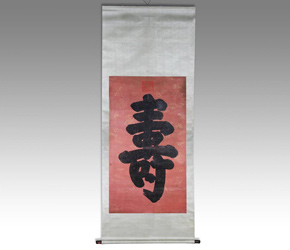 |
|
Considering the history of written language throughout the world, Japan was fairly late in the game compared to other cultures. Cuneiform writing was first established over 5,000 years ago by the Sumerians between 3,500-3,000 BCE. Egyptian hieroglyphics soon followed, dating back to 3,300 BCE, and China’s logo-graphic writing system on oracle bones emerged around 1,200 BCE. The Greek alphabet emerged around 800 BCE and the Roman alphabet followed a century later. In comparison, the Japanese likely had no written language until the 1st century AD. At that time, emissaries from China brought diplomatic gifts embellished with written inscriptions. The earliest known such artifact was a golden seal, said to be presented by Emperor Guangwu of the Han Dynasty. However, it took a few more centuries before the Japanese would become fully literate in the complex Chinese character system, which came to be called Kanji , translated as “Characters from Han.”
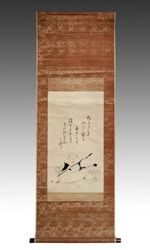 |
|
At first, Kanji was used only to read Classical Chinese works and not to express vernacular Japanese. This changed during the Heian Period (794-1185) with the emergence of new systems of reading and writing called Kana. These systems were based on phonetic sounds just like the ABCs of English, for example. It is widely believed a Buddhist Monk named Kukai initiated the development of Kana. In the early 800s, Kukai took part in an official mission to China. At that time, he was initiated into the practice of Vajrayana Buddhism. By the end of his mission Kukai brought back to Japan his Buddhist practice as well as many texts and valuable knowledge concerning the art of calligraphy. His Buddhist practice gave birth to the Shingon Sect, and although it has never been definitively proven, it is widely believed his work resulted in three separate writing systems that were used together. The first, Kanji, was based on Chinese with well over 50,000 characters. The second and third, Hiragana and Katakana, each had 46 phonetic symbols based on sounds rather than meaning. It was the combination of these systems that enabled Japanese writing and calligraphy to become a unique language and art form. Ultimately, Kukai became celebrated as one of the greatest calligraphers in Japanese history alongside the Heian Emperor Saga and government official Tachibana-no-Hayanari. Collectively, they are known as the Sanpitsu or “Three Brushes.”
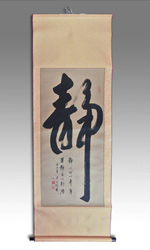 |
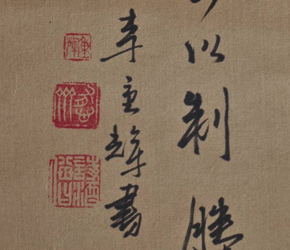 |
|
Part of what makes calligraphy an art form is the spiritual and disciplinary aspects of the practice, which extend back to the days when writing was a form of devotional training for young monks. They would spend days reproducing Confucian and Buddhist texts by copying the contents word for word. Above all, calligraphy masters preach the importance of achieving a state of “nothingness” in one’s mind and heart when practicing calligraphy. It is upon this clean slate that characters eventually emerge. In this regard, calligraphy may even be considered a form of meditation. The words manifesting on paper represent a reflection of the calligrapher’s spirit. They are totally unique and singular. This is what differentiates calligraphy from handwriting and one of the reasons viewers can feel familiar with authors of calligraphy done centuries earlier.
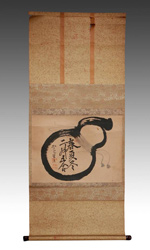 |
|
While the meditative aspect of calligraphy relates to the state of the calligrapher, the “Four Treasures of the Study,” which originated in China, refer to the material objects needed to make calligraphy. They are the brush, ink, ink stone and paper, collectively known as Bunbou Shihou in Japanese. Of these, paper was selected as an Intangible Cultural Heritage by UNESCO. Japanese rice paper is collectively known as washi, but not all washi is equally made. Only three types of washi have been selected by UNESCO. They are: Sekishuu Banshi from Shimane prefecture, Honminoshi from Gifu prefecture, and Hosokawashi from Saitama prefecture. The common characteristic of these three types of washi is they are made solely from theinner fibers of Kozo, a type of mulberry tree. Most washi use fibers from trees imported from other Asian countries, but the washi produced in Shimane, Gifu and Saitama prefectures come from the homegrown kozo tree. These trees produce fibers with unusually high concentrations of oil, a desirable characteristic when it comes to the production of washi paper. In addition, they are produced by hand during the cold winter months when the water is purest. The result is each sheet of washi is different. In turn, gives unique expression to calligraphy works and other art produced on this type of rice paper. Generally speaking, washi is highly admired by artists from all over the world for its warmth, light weight, translucency, and the long fibers that help preservation. Famous artists in the West such as Rembrandt, Picasso and Chagall were among those fascinated by the durability and unique characteristics of washi.
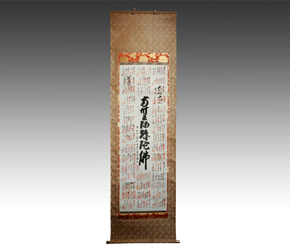 |
|
Although the skills of making brushes and ink already existed in Japan before Kukai’s mission to China, it is said the knowledge he brought back greatly enhanced the techniques used by craftsmen. Kukai passed on his knowledge to a brush maker called Sakanai Kiyokawa in Nara, the old capital of the Heian Period. Since that time, Nara has been considered an important location for the production of calligraphy brushes. The establishment of the Kana writing system, which introduced more rounded curves compared to Kanji characters, created the need for finer, more delicate brushes. This led to the Japanese innovation of brushes using the hair of multiple animals. For example, Nara brushes use the hair of up to 10 different species of animals. Each one brings out a different characteristic, which can also change depending on the season (whether it’s from the summer or winter coat) and the area of the body where it grew. For example, there is inner fur, outer fur, hair from the belly and so on. It takes knowledge and careful examination by the brush maker to repeatedly clean, sort and select the finest hair, which is then further refined and hand-bound to the stalk. Today, brushes from the cities of Nara, Toyohashi, Kumano and the small town of Kawajiri have been recognized by the Ministry of Economy, Trade and Industry as Designated Traditional Japanese Crafts because of their exceptional quality.
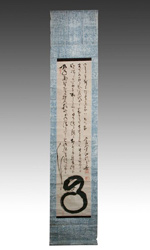 |
|
The city of Nara is also the capital of ink making. Ink has been made there going all the way back to the time of Kukai. Although the craft of ink making spread to all corners of the country, reaching a peak during the Kamakura Period (1185-1333), the most skilled craftspeople gathered in Nara. Today, it is one of the last places still making ink according to formulas now over 1,000 years old. Essentially, ink is soot kneaded with animal glue, which is then pressed and dried in wooden molds. Later, it may be reconstituted by grinding the dried ink and mixing it with water. The process of making ink may be lengthy and complex. At times it requires delicate tasks such as gathering thin layers of soot from earthenware lids covering burning candles. At other times, it involves strenuous labor when the soot is kneaded together with glue made from animal fat. Finally, after kneading it is pressed into a wooden mold and left to dry and harden. Ink may vary according to the type of soot and how it was gathered, the type of glue, how long the mixture was kneaded, and a host of other nuanced factors. Even the mold had an effect on the glue and how it was valued. Often, the mold itself is carved with calligraphy scripts bearing names, poems, sutras or visual designs. Some molds were even carved with detailed scenes and beautiful landscapes. It was not unusual for molds to be handed down from one generation of ink makers to the next. The ink, removed from the mold in hardened form, revealed the beauty of the mold designs. Today, the most intricate designs are carved by the last living ink stick wood carving specialist, Nakamura Gahou, who is the 7th generation master of his family lineage.
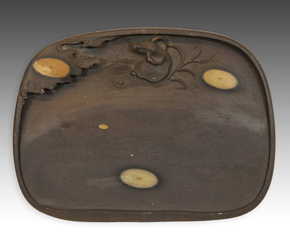 |
|
Whereas the previous three treasures of the study are composed of multiple elements assembled by hand, the ink stone alone is a single natural product. Most ink stones are made from slates, which are fine-grained and primarily composed of clay minerals. As important as it is for calligraphers to acquire high quality ink, some experts argue the quality of the ink stone is more important. Even average ink, when ground on a superior stone, will produce a surprisingly pleasing depth of color and fineness. The grinding of ink on the stone is one of the most crucial steps in the art of calligraphy. It is generally agreed, rushing to grind the ink will never produce a satisfactory color. Instead, an old saying wisely suggests, “Let an old man or small infant grind the ink.” In other words, it takes a gentle, steady hand to produce the best ink. In Japan, there are several famous stones used for ink stones. These include the Akama stone from Yamaguchi prefecture and Nachiguro stone from Mie prefecture; however, the most famous is the Ogatsu stone from Miyaji prefecture. Up to 90% of all ink stones in Japan were composed of Ogatsu stone, but this stone has become very rare due to the 2011 earthquake and tsunami, which damaged the quarries where the stones were found.
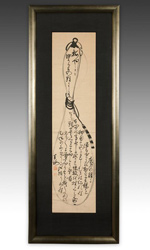 |
|
In China and Japan calligraphy began as a communications tool, serving for most of its history as the only means of leaving written records. Today, it is no longer a practical tool, having been replaced by “normal” writing using other instruments – ballpoint pens, pencils and even computers. In the wake of these modern developments calligraphy has been elevated to a tool of creativity and aesthetics; in short, an art form. Behind the seemingly straight-forward black and white image of the words it presents lies thousands of years of history. Add in the world of artistry involved in crafting the Four Treasures of the Study, and – in a sense – you will find art within art.
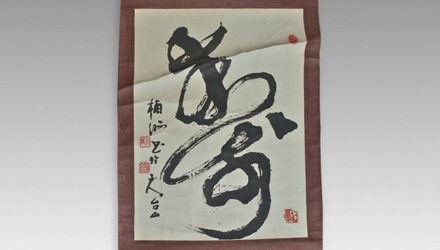 |